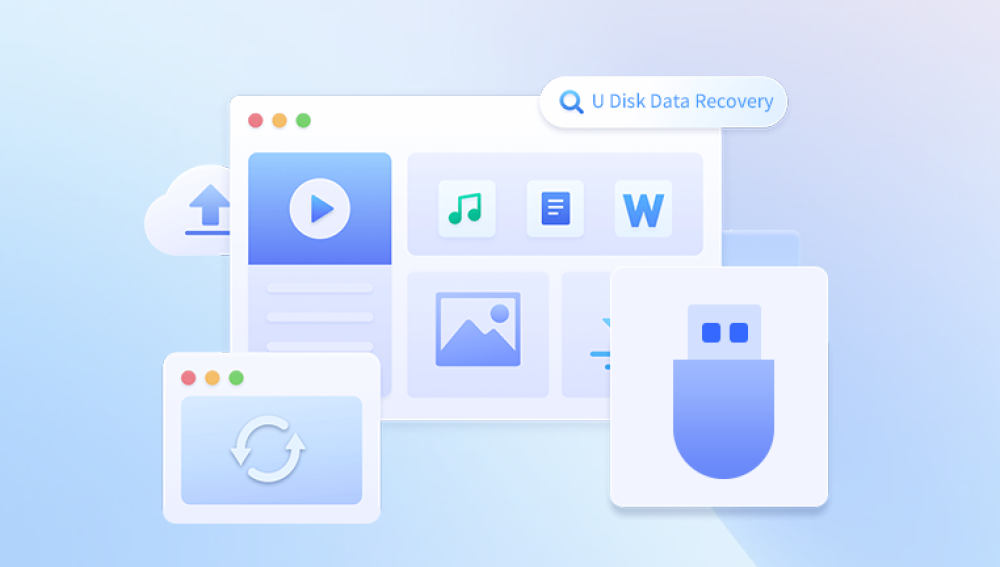Flash drives (also known as USB drives, thumb drives, or pen drives) have become one of the most popular and convenient ways to transfer and store data. From school assignments to work reports and cherished personal files, we rely heavily on these tiny portable devices. But what happens when you accidentally delete an important file or format your flash drive by mistake?
Fortunately, deleted files from flash drives are not always gone forever. Whether you hit "Delete," used "Shift + Delete," or mistakenly formatted your drive, there's a good chance you can recover the files if you act quickly and use the right tools.
Chapter 1: Understanding File Deletion on a Flash Drive
1.1 What Happens When You Delete a File?
When you delete a file from a USB flash drive, it usually doesn’t go to the Recycle Bin (unlike files deleted from your desktop or internal hard drive). Instead, the file is marked as deleted in the file system, and the space it occupied becomes available for new data.

Important: The file remains on the drive until it is overwritten by new data. That’s why you must stop using the flash drive immediately after realizing the data is deleted.
Chapter 2: Preliminary Steps Before Recovery
Before attempting any advanced recovery, follow these essential tips:
2.1 Stop Using the Flash Drive
Unplug the drive to prevent new data from overwriting deleted files.
2.2 Avoid Formatting
Do not format the flash drive if prompted. Formatting can overwrite data, making recovery more difficult.
2.3 Check for Hidden Files
Sometimes, files aren’t deleted—they’re just hidden.
To check:
Open File Explorer.
Click “View” > “Show” > “Hidden items”.
Look for your missing files.
Chapter 3: Check the Recycle Bin (Unlikely, But Worth It)
In rare cases, if you deleted files via drag-and-drop into the Recycle Bin, they might still be there:
Open the Recycle Bin on your desktop.
Look for files that were on your flash drive.
If found, right-click and select “Restore”.
Chapter 4: Use File History (Windows) or Time Machine (Mac)
If you’ve enabled backup solutions on your system:
4.1 On Windows:
Connect your flash drive.
Go to the folder where the file was previously located.
Right-click and choose “Restore previous versions”.
Select the version you need and restore it.
4.2 On Mac:
If you back up using Time Machine:
Connect the flash drive.
Open Time Machine.
Navigate to the desired folder and restore the deleted files.
Chapter 5: Use a Data Recovery Tool
If the above methods don’t work, you’ll need data recovery software.
5.1 Recommended Tools
Drecov Data Recovery
Drecov Data Recovery is a powerful, user-friendly tool designed to help you recover deleted files from a wide variety of storage devices, including hard drives, flash drives, SD cards, and external USB drives. Whether you’ve accidentally deleted an important document, lost data due to formatting, or experienced a system crash, Drecov Data Recovery offers a practical and effective solution to retrieve your files quickly and safely.
One of the key strengths of Drecov Data Recovery is its intuitive interface. You don't need to be a tech expert to use it. Just install the software, select the drive where your files were lost, and choose between a quick scan and a deep scan. The program will then list all recoverable files, allowing you to preview and restore the ones you need.
5.2 Steps to Use Drecov Data Recovery
Download and install Drecov Data Recovery on your computer (not on the flash drive).
Insert the flash drive into your USB port.
Launch the software and select the flash drive from the list of available drives.
Choose Quick Scan or Deep Scan (recommended for formatted or overwritten files).
Wait for the scan to complete.
Browse through recoverable files. Use preview to check file content.
Select files you want to recover.
Click Recover, and save the files to a different drive (never save to the same flash drive).
Chapter 6: Recovering from a Formatted Flash Drive
Formatting doesn’t necessarily erase the files—it only removes the file system. You can still recover data if you:
Avoid writing new data
Use Deep Scan mode in recovery tools like Drecov Data Recovery
Recovery Steps:
Use the same steps as in Chapter 5.
Make sure to select “Formatted Recovery” or “Deep Scan.”
Recover files to a different location.
Chapter 7: Recovering Corrupted or Unreadable USB Drives
If your USB isn’t being recognized, or shows errors like “Please insert disk,” you can still attempt recovery.
7.1 Check Disk Utility (Windows)
Open Command Prompt as administrator.
Type:
bash
CopyEdit
chkdsk X: /f
Replace “X” with the flash drive’s letter.
This can repair minor file system issues.
7.2 Disk Management
Go to Disk Management and see if the drive appears.
If visible but unallocated, don’t format—use a recovery tool instead.
Chapter 8: Using Command Prompt to Recover Files
Windows Command Prompt can be used to attempt file recovery.
Steps:
Open Command Prompt as Administrator.
Type:
bash
CopyEdit
attrib -h -r -s /s /d X:\*.*
Replace “X” with your flash drive letter.
This command restores hidden and system-protected files.
Chapter 9: Recovering Specific File Types
Most recovery software supports filtering files by type. Common formats:
Documents: .docx, .pdf, .txt
Media: .jpg, .png, .mp4. .mp3
Spreadsheets: .xlsx, .csv
Compressed: .zip, .rar
Use the filter option in tools like Drecov Data Recovery to quickly find these file types.
Chapter 10: Manual File Recovery on Mac
Use Terminal:
Open Terminal.
Type:
bash
CopyEdit
ls /Volumes
Find your flash drive.
Try:
bash
CopyEdit
ls -al /Volumes/[FlashDriveName]
Use cp to copy visible files to another location.
For deleted files, use software like Disk Drill for Mac or Stellar for Mac.
Chapter 11: Recovery from Physically Damaged Flash Drives
If your USB drive has physical damage:
Don’t try DIY fixes (like heating, bending, or freezing it).
Use professional recovery services, especially if the USB contains critical data.
Services like DriveSavers and Ontrack specialize in hardware-level recovery.
Chapter 12: Best Practices to Avoid Data Loss
12.1 Backup Your Flash Drive Regularly
Use cloud storage or external hard drives.
12.2 Eject Safely
Always use “Safely Remove Hardware” to avoid corruption.
12.3 Avoid Excessive Writing and Deletion
Flash memory has a limited number of write cycles.
12.4 Use Antivirus Software
USBs are prone to malware attacks. Always scan your drives.
Start with simple checks like viewing hidden files or looking in backups. If those fail, use a reliable recovery tool like Drecov Data Recovery to perform a deep scan and retrieve your deleted files. For physical damage, don’t hesitate to seek professional help.




